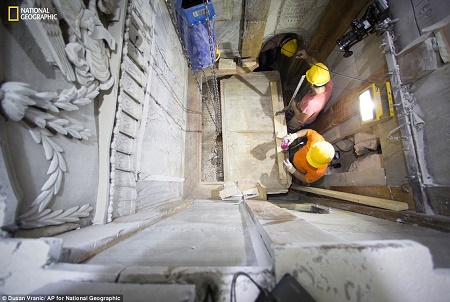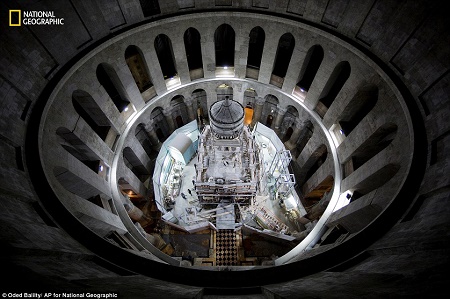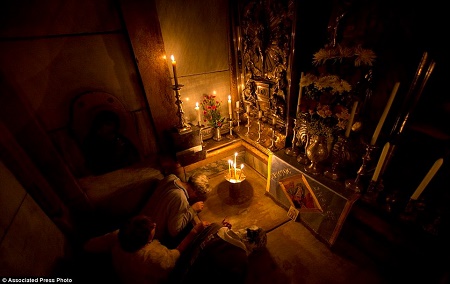Religion
Scientists Finally Uncover the Tomb that Held the Body of Jesus Christ for the First Time in Centuries (Photos)
Scientists have uncovered the slab holding the body of Jesus Christ for the first time in centuries.
The burial slab that many Christians believe once held the body of Jesus Christ has been uncovered by scientists for the first time in centuries.
The original surface was exposed during the restoration work being done at the Church of the Holy Sepulchre in the Old City of Jerusalem, according to the National Geographic .
Until then, marble had encased the slab since at least 1555 AD.
The organization is filming the work being done at the church, which is considered the most sacred site in Christianity.
Fredrik Hiebert, the National Geographic Society’s archaeologist-in-residence, said: ‘The marble covering of the tomb has been pulled back, and we were surprised by the amount of fill material beneath it.
‘It will be a long scientific analysis, but we will finally be able to see the original rock surface on which, according to tradition, the body of Christ was laid.’
Christian tradition says Christ’s body was laid on a slab cut from a limestone cave after his crucifixion by the Romans more than two thousand years ago.
He was resurrected three days after his death, according to scripture, and the women who came to anoint his body said no remains were found.
The burial slab was enclosed in a structure known as the Edicule – a word derived from the Latin term aedicule meaning ‘little house.’
An ornate structure with hanging oil lamps, columns and oversize candlesticks, the Edicule was erected above the spot where Christian tradition says Jesus’ body was anointed, wrapped in cloth and buried before his resurrection.
It stands a few hundred yards from the site of Jesus’ crucifixion.
With its stone staircases, gilded ornamentation and many dark chambers, the church is one of Christianity’s holiest shrines.
But that hasn’t stopped clerics from engaging in turf rivalries over the years.
The Roman Catholic, Greek Orthodox and Armenian churches are responsible for maintaining separate sections, and each denomination jealously guards its domain. While the clergymen who work and pray at the church generally get along, tensions can rise to the surface. In 2008, an argument between Greek Orthodox and Armenian monks erupted into a brawl.
This time, the clergymen put aside their differences — a reflection of the dire need for the repairs. Last year, Israeli police briefly shut down the building after Israel’s Antiquities Authority deemed it unsafe, prompting the Christian denominations to join forces.
The Edicule and the tomb are currently being restored by scientists from the National Technical University of Athens.
The university’s chief scientific supervisor Professor Antonia Moropoulou told National Geographic that it is ‘the critical moment’ for restoring the Edicule.
It was last reconstructed in the early 19th century after a fire destroyed it. But repairs are long overdue as the structure it was damaged in an earthquake in 1927.
Lack of financial resources prevented the work from being done, but donors to the project – estimated at more than $4 million (£3.26 million) – include Jordan’s King Abdullah II, and Mica Ertegun, who gave $1.3 million (£1.06 million) to the World Monuments Fund to support it.
Earlier this year, the Greek Orthodox Patriarchate of Jerusalem, as well as the the Roman Catholic Church, and the Armenian Orthodox Church (the three main out of six Christian sects that have custody of the church) invited the NTU to lead the restoration project.
Work is expected to be complete in the spring of 2017. The church, one of the world’s oldest, was built in 325 A.D. by the Roman Emperor Constantine.
That structure was destroyed in 1009 by Muslim Caliph al-Hakim. A 12th-century restoration by the Crusaders gave the Holy Sepulchre its current appearance, while in 1808 a fire all but destroyed the Edicule.
In 1852, the Ottoman authorities then governing the Holy Land provided a framework for resolving disputes inside the church.
They put into effect the ‘status quo,’ a set of historic laws and power-sharing arrangements that rigidly regulates the denominations’ activities inside the Holy Sepulchre.
The Rev. Athanasius Macora, a Franciscan monk who represents the Catholics at the inter-church commission that negotiates disputes at the Holy Sepulchre, said the renovation might have been more ambitious if not for the status quo rules.
‘I personally would have liked to maybe contemplate some alternative to simply restoring the current structure. But because the status quo is so conservative in its nature . we had to more or less accept the fact that there would be no change whatsoever to the current structure, and it would be restored as it is now,’ he said.
Still, for pilgrims like Italian Claudio Pardini, the restoration is ‘an important sign’ that all of the Christian churches are getting together to preserve their faith’s traditions.
‘It’s good to take care of our churches so that we can leave the next generations a sign, something to visit,’ he said. ‘Because Christ isn’t an idea. He’s a story.’
Source: Dailymail
Follow us on social media:-
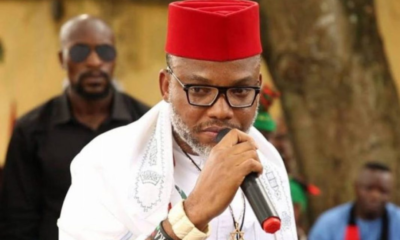
 Biafra1 day ago
Biafra1 day agoIPOB lawyer, Ejimakor Rejects FG’s Move To Set Date For Resumption Of Nnamdi Kanu’s Trial
-
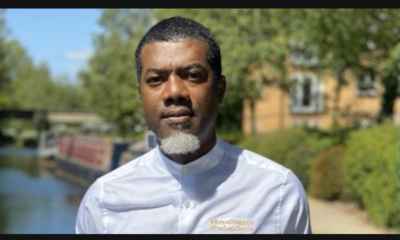
 News1 day ago
News1 day ago“Why I Stopped Supporting Atiku Abubakar” – Reno Omokri reveals
-

 Education1 day ago
Education1 day agoNYSC DG speaks on N77,000 monthly allowance for Corpers
-

 Crime1 day ago
Crime1 day agoPolice arrest father and son for alleged m#rder of kinsman in Imo

